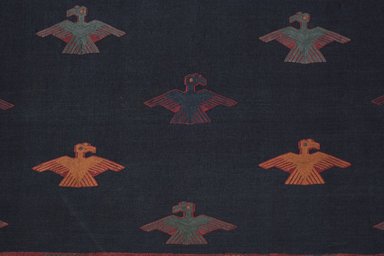
Artist:NascaParacas Necropolis
Medium: Camelid fiber
Geograhical Locations:
Dates:0-100 C.E.
Dimensions: 108 11/16 x 50 13/16 in. (276.1 x 129.1 cm)
Collections:
Accession Number: 34.1553
Image: 34.1553_detail01_PS11.jpg,
Catalogue Description: Size: adult; probable wearer: male. Plain weave with horizontal camelid fiber warp, camelid fiber weft and camelid fiber embroidery. The imagery consists of embroidered condors on the dark blue field and along the borders. The birds are rendered in colors of green-blue, dark blue and orange. Portions of the borders have fringes at their outer edge. From Mary Frame's notes: The fleshy carbuncle above the beak and the long flight feathers are distinctive features of condors. Other dominant traits are the outspread flying-wings depicted as if seen from below; the condors are shown as if swiveled to the side with the beak in profile. The border figures are unusual in being oriented transversely; they alternate up and down rather than left and right. This orientation is almost exclusively used for condors or humans with condor attributes (Boston Museum of Fine Art 16.342 and matching ponchito); very rarely for falcons (MfV Berlin 63321); and almost never for other figures. In the field, horizontal rows alternate laterally by pairs of rows rather than single rows, uncommon but not unique. The background of the border, with the subtle chevron pattern created by changing the diagonal S- and Z-slant of the stitching, is unusual. Other examples of Paracas textiles with condor figures oriented transversely show an elaborately attired human figure with condor wings outspread; the figure likely representing a mythic transformation to condor. This mantle stands out for its impeccable workmanship and completeness. Comparative examples with condors in this orientation are patterned in only one-half of the field.